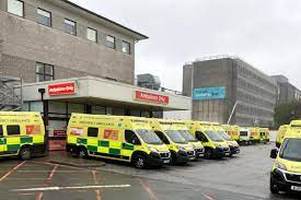Do we really need more ambulances?
Accessing old blogs
Before diving into this week’s blog, I said last time that I would explain how to access past blogs by subject matter. This week it has suddenly become very easy – just look at the “Categories” list on the right side of this page, below the picture, and click on any topic which interests you. All past blogs which report on this category come up.
“NHS to buy hundreds of ambulances”
That was a headline in the Sunday Times last week and it set me thinking – do we really need the “hundreds of ambulances” promised us by the NHS. It seems to me that this is an inappropriate response to our current Health Service crisis, both in the short term and in the long term.
In the short term
It is not a shortage of ambulances that leads to them piling up outside A&E departments. The blockage is within the hospitals who have up to one third of their beds occupied by people who have recovered but are too frail to be sent home to look after themselves. Something needs to be done but it makes much better sense to tackle the root of the problem – which is not a shortage of ambulances but the delays in discharging patients caused by the log-jam in the A&E departments caused the large numbers of patients stuck in hospital when they are clinically ready to go home. The two reasons for this bed-blocking are
1. The poor and state of health of our frail elderly who make the most part of acute hospital admissions.
2. The inadequate numbers of carers and care home places.
If immediate action is to be taken it must be to address the second problem by increasing the provision care. More ambulances can only help by looking after more patients while they queue. And who will drive them?
In the long-term
The only long-term remedy for the current muddle is to improve the health of our elderly population. This population is largely unhealthy, frail and dependent – an entirely preventable state of affairs.
Poor health and debility in old age are largely the result of low levels of physical fitness due to inadequate exercise over a very long period. Observational studies show that less than 15% of the population and less than 5% of the elderly take enough exercise to benefit their health. The result is that a staggering 20% of the average citizen’s life is spent with chronic disease in old age – such conditions as obesity, diabetes, heart disease, lower limb arthritis, dementia and ultimately frailty.
The risk factor which is common to all of these conditions is low levels of exercise and physical fitness. All are frequent contributors to the need for emergency admission – partly because the unfit suffer more serious effects from inter-current illness and partly because they are less able to cope at home. Once admitted, bed and chair rest are the order of the day with the inevitable sharp decline in physical fitness. By the time they have recovered sufficiently to be discharged their fitness has often fallen below the level needed for independent living.
Frailty leads to susceptibility to falls, injuries and acute illnesses which are followed by a cascade of disasters – calling the ambulance, queuing outside A & E department, waiting for hours on a trolley, eventual admission and, after treatment, weeks spent in hospital waiting for suitable care after discharge. The feedback loop is continuous.
I am reminded of Joseph Malins’ famous poem, The Ambulance Down In The Valley, which describes the debate about the best way of reducing the ill effects of people falling off a cliff. Initially they installed an ambulance in the valley at the foot of the cliff. The counter argument was:
“Better put a strong fence round the top of the cliff
Than an ambulance down in the valley”
and
“If the cliff we will fence, we might almost dispense
With the ambulance down in the valley”
The top of our current health cliff is the pandemic of old and frail people who make up such an alarming proportion of our elderly population. We cannot reduce the number of the elderly but we can improve their health. The much needed fence is a programme to increase the physical fitness/health of our population – particularly in later life.
The building of the fence needs political action, with money and resources spent persuading older people of the importance of regular exercise and giving them the means to do it. Encouraging and facilitating regular exercise for all, particularly those at and beyond middle age, should be a priority for the Health Secretary and his/her department.
“To rescue the fallen is good, but ’tis best
To prevent other people from falling”.
Subscribe to the blog
Categories
- Accelerometer
- Alzheimer's disease
- Blood pressure
- BMI
- Cancer
- Complications
- Coronary disease
- Cycling
- Dementia
- Diabetes
- Events
- Evidence
- Exercise promotion
- Frailty
- Healthspan
- Hearty News
- Hypertension
- Ill effects
- Infections
- Lifespan
- Lipids
- Lung disease
- Mental health
- Mental health
- Muscles
- Obesity
- Osteoporosis
- Oxygen uptake
- Parkinson's Disease
- Physical activity
- Physical fitness
- Running
- Sedentary behaviour
- Strength training
- Stroke
- Uncategorized
- Walking


